 This past summer, 11 students majoring in environmental science and geology spent 12 days along the shores of the Great Lakes as part of a geology field excursion course taught by USI professors Dr. Paul Doss and Dr. Tony Maria.
This past summer, 11 students majoring in environmental science and geology spent 12 days along the shores of the Great Lakes as part of a geology field excursion course taught by USI professors Dr. Paul Doss and Dr. Tony Maria.
Students learned about a host of geological features and processes including shoreline processes, erosion of the Great Lakes, changing lake levels, and the formation of Lake Michigan; Devonian fossils and Petoskey Stones; the geology of Pictured Rocks National Lakeshore; Archean rocks of the Upper Peninsula of Michigan; Paleoproterozoic stromatolites; Mesoproterozoic Banded Iron Formations, native copper deposits and the geology of the Keweenaw Peninsula; and intrusive rocks of the Mellen Intrusive Complex.
 A typical work day began with gathering equipment and packing vehicles before heading to their location for the day. Once the group arrived, a few students gave a presentation based on the location and topic they had researched for the trip.
A typical work day began with gathering equipment and packing vehicles before heading to their location for the day. Once the group arrived, a few students gave a presentation based on the location and topic they had researched for the trip.
Throughout the trip, the students made observations of the coastal system around the Great Lakes, comparing how it is similar to a marina coastline. In the field, students observed and collected data on new geological locations, rocks and landscapes outside of the southern Indiana terrain they are used to. In Marquette, Michigan, they met with a city planner who discussed issues of coastal erosion around Lake Superior, shoreline development issues, and how geology and ecology go into planning.

The group also collected native copper ores and learned about the history and resources near a historic mining district as part of the cultural development segment of the course.
Student also broke out of their own cultural comfort zone, eating new cuisines such as fish sausage, smoked whitefish, and pasties, a traditional meat pie associated with miners from Cornwall, England, who settled in Upper Michigan on the Keweenaw Peninsula, where they discovered Yooperlite rocks that are rich in fluorescent sodalite making them glow under UV lights. The class also discovered Petoskey, the state stone of Michigan, a pebble-shaped rock of fossilized coral.
The trip concluded with a ride on the S.S. Badger Car Ferry from Manitowoc, Wisconsin, to Ludington, Michigan, to avoid Chicago traffic.
More photos and information about the trip are available on the USI Geology and Physics Facebook page.
Colorado Field Trip - Summer 2017
For two weeks during the summer of 2017, students enrolled in GEOL 390 experienced geology and hiking in the mountains of Colorado. Our adventure included climbing along the Crags on Pikes Peak, long hikes to Grizzly Lake and Ice Lake, excursions through several old mining camps, a hike to the headwall of the Slumgullion Earthflow (a slow-moving landslide), a visit to the Spanish Peaks, visits to volcanic features on Grand Mesa, the West Elk Mountains and the San Juan Mountains, and a visit to the Capulin Volcano in New Mexico.
 |
| On the way to Ice Lake in the Colorado Rocky Mountains. |
 |
|
David Woosley, USI environmental science major, points out the Great Unconformity between underlying granitic rock and much younger sedimentary rock. |
 |
| The Crags on Pikes Peak in Colorado. |
 |
| USI Geology majors are examining piles of gravel left by a giant gold-mining dredge boat. |
The Great American Solar Eclipse at USI - August 21, 2017
 |
We had the rare opportunity to observe a near total solar eclipse on the University Quad on August 21, 2017. USI Geology & Physics invited over 700 students from Elementary and Middle Schools in our region for activities and viewing of the solar eclipse on campus. There were several solar-filtered telescopes, along with eclipse glasses, with which the entirety of the eclipse was safely observed. The maximum eclipse occurred at 1:24 p.m. Many thanks to Matthew Merlo and Jeff Polak for all of their hard work in making this event a huge success.
 |
| Dr. Matthew Merlo presenting a lecture on the science of a solar eclipse in the USI Theatre. |
 |
 |
|
USI students checking out a projection of the eclipse using a pegboard stand. |
Student examining projection of the eclipse using a modified telescope. |
 |
| Solar eclipse with 99 percent lunar coverage on the University Quad. |
 |
 |
|
Students preparing to observe the solar eclipse on the University Quad at USI. |
Dr. Kent Scheller assisting students with viewing the solar eclipse through a telescope. |
Physics Welcomes Dr. Kloosterman - August 2017
 |
|
Dr. Jenna Kloosterman will be joining the Physics faculty starting in Fall 2017 and has a joint appointment with Engineering. She received her Ph.D. in Electrical Engineering and M.S. Degree in Astronomy from the University of Arizona. Most recently, Dr. Kloosterman was a RF Microwave Engineer at the Jet Propulsion Laboratory (JPL) in Pasadena, California. Her research focuses on high frequency heterodyne receivers for radio astronomy. She has worked on 1.46 and 1.9 THz local oscillators and mixers for the Stratospheric Terahertz Observatory 2 (STO-2), which is a balloon-borne observatory designed to map star forming regions in the galactic plane. Welcome Dr. Kloosterman to USI! |
Field Trip to Monroe and Brown Counties – April 2017
Students in Sedimentology & Stratigraphy went on a field trip to visit several classic localities in Monroe and Brown Counties in Indiana to examine limestones and the underlying deposits of the Borden Group. Students collected fossils from several limestone units, and observed many sedimentary structures in the field. Geology field trips provide students the opportunity to learn by doing!
 |
 |
|
Students taking notes on their observations of the St. Louis Limestone near Bedford, Indiana. |
Student collecting fossils from the Edwardsville Formation near Bloomington, Indiana. |
Field Trip to Peabody Coal Mine – March 2017
Geology and Environmental Science majors at USI had the opportunity to visit an active coal mine near Mackey, Indiana. In addition to learning about the Pennsylvanian stratigraphy, students were able to see an operational Dragline. Field trips provide students with valuable hands-on learning experiences and an opportunity to explore various career opportunities.
 |
 |
| Group picture of students & faculty in the scoop of the Dragline. | Students checking out a Dragline. |
Physics Degree Program - September 2016
Starting in Fall 2016, USI students may earn a BS/BA in Physics. Students pursuing a Physics major at USI will have four tracks to choose from:
Finally, the major in physics will open doors to multiple post baccalaureate opportunities: graduate studies (physics, astronomy, engineering, medicine, law e.g.), teaching (secondary), and research and development at major facilities.
Physics Welcomes Dr. Deligkaris - August 2016
 |
|
Dr. Christos Deligkaris will be joining the Physics faculty starting in Fall 2016. He received his Ph.D. in Physics from Purdue University. Most recently, Dr. Deligkaris was a faculty member in the Department of Chemistry and Physics at Drury University in Missouri. His research focuses on predicting the physicochemical mechanisms by which molecules, including mutagens, carcinogens, and drugs, interact with DNA molecules. The ultimate goals of his research are to achieve a molecular-level understanding of carcinogenesis, to help develop strategies that prevent carcinogenesis, and to help develop better treatment therapies. Welcome Dr. Deligkaris to USI! |
Field Trip to Monroe and Brown Counties – April 2016
Southern Indiana provides an incredible outdoor laboratory to study geology and surface processes. In early April, students enrolled in GEOL 316: Sedimentology and Stratigraphy at USI visited several classic localities in Monroe and Brown Counties in Indiana to examine limestones and the underlying deposits of the Borden Group. Deposits of the Borden Group are interpreted to document a delta that extended into the Illinois Basin during the Early Mississippian, carrying sediment from the eroding Acadian Mountains to the east. In the Late Mississippian, a shallow seaway transgressed over southern Indiana, depositing fossiliferous limestones, including the Salem Limestone, the State Rock of Indiana.
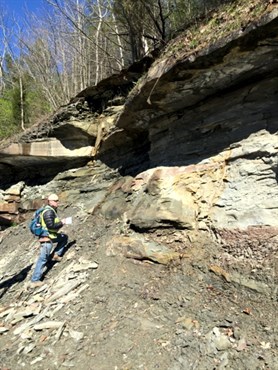 |
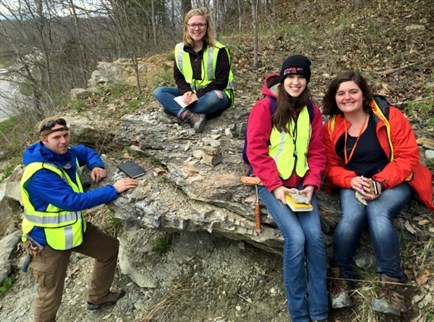 |
| Student examining bedded sandstones, siltstones, and shales of the Spickert Knob Formation of the Borden Group, | Students taking a break from field work to enjoy the comfort of an exposed ledge of skeletal limestone of the Edwardsville Formation. |
Students observed numerous sedimentary structures in the field, including cross-bedding, climbing ripples, convoluted bedding, stylolites, trace fossils, and ripples. Students also examined geodes and collected minerals, including sphalerite, calcite, dolomite, and quartz. Students constructed stratigraphic sections and interpreted depositional settings of various sedimentary rocks in the field.
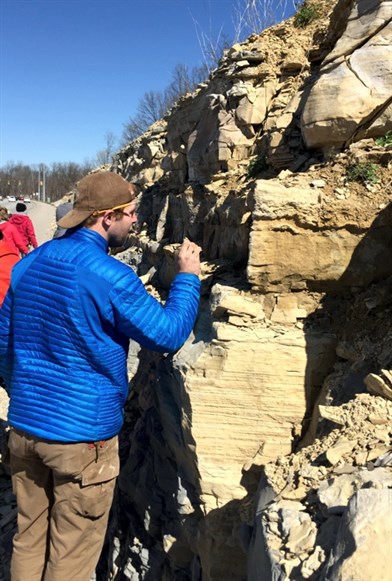 |
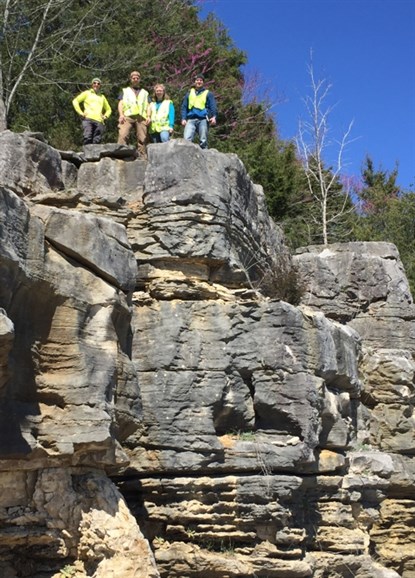 |
| Exposure of St. Louis Limestone in Bloomington, Indiana. | Students standing on cliffs of the Salem Limestone. |
"Science with A Twist" – March 2016
Over the last few months, the Evansville Museum of Arts, History and Science, along with the Indiana Academy of Science, has sponsored a new event called "Science with a Twist" at Bokeh Lounge in Evansville. The speaker on March 16, 2016 was Dr. Paul Doss, who presented "What in the world are we doing to our world?" that focused on global climate change, the sixth major extinction event, and the Anthropocene.
On Wednesday, February 17, 2016, Dr. Kent Scheller and Dr. William Elliott presented "Evansville has Gas: Radon" at Bokeh Lounge. This talk focused on the dangers of radon in the Tri-State region and controlling factors that may result in elevated radon levels in your home.
New Physics Degree at USI – February 2016
The Indiana Commission of Higher Education approved the offering of a new Physics degree at USI at its February 2016 meeting. The physics degree program was approved by the USI Board of Trustees in November 2015. The new physics degree program will begin in Fall 2016 and will enable students to select one of four tracks depending on their professional aspirations. The traditional track will prepare students for pursuit of an advanced degree in Physics, the teaching track will permit students to work in Secondary Education, the applied track will enable students to pursue careers in STEM fields, and the computational track will permit students to secure jobs in computing and analytics. While there are differences in these four distinct tracks, all physics majors will be expected to complete a core set of courses, as well as the completion of a senior thesis.
Dr. Kent Scheller, Associate Professor of Physics, said “many of our current biophysics majors are excited about a physics degree at USI, and several other undeclared majors have already expressed interest in the new program.”
As part of the program, students will be engaged in hands-on activities in the laboratory, have the opportunity to travel to conferences, and participate in summer research programs. To enhance the student learning experiences in physics, the Department will be acquiring about $20,000 worth of new equipment.
Wright Illuminates on Gemstones in Jane Austen’s Time – January 2016
Carrie Wright, Instructor of Geology, published "Unbearably Fine”: The Socio-Political Powers of Jewelry in Jane Austen’s World in the on-line journal Persuasions in December 2015. The article summarizes jewelry styles in the late 18th to early 19th Century. Ms. Wright also examines the social and political power dynamic of jewels in Jane Austen’s writings and novels.
Field Trip to Hastie Fluorite Mine – December 2015
The motto of the Pott College is "Learning by Doing". For geologists, this means trips to observe geologic features or deposits in the field. One of the most important economic resources of the Tri-State region was fluorspar, once used in the smelting of iron and in steel production. Although fluorite is no longer mined in this region, the mine is still active, providing aggregates to the area.
 |
| Exposures of the St. Genevieve Limestone and Renault Formation overlain by the Bethel Sandstone (Mississippian) in the Hastie Quarry. |
In the Hastie Mine, fluids rich in calcium and fluorine replaced carbonate along bedding planes and precipitated in vugs to form purple fluorite. Hastie’s Quarry is a series of open-pit aggregate mines along the the faulted front of Spar Mountain. Spar Mountain is a ridge of St. Genevieve Limestone and Renault Formation (Mississippian) overlain by a cap of resistant Bethel Sandstone.
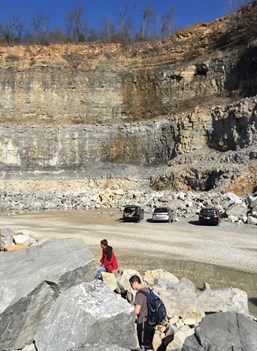 |
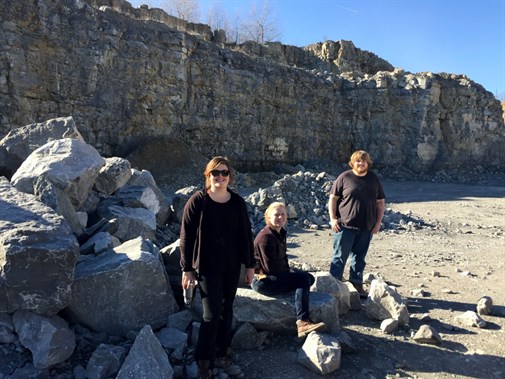 |
| Students collecting fluorite and other minerals from aggregate piles in the Haste Mine near Cave-in-Rock, Illinois. | Students enjoying the unseasonably warm weather in late December in the Haste Mine collecting fluorite and other minerals. |
Geology Field Excursions – November 2015
Every summer, USI students have the opportunity to enroll in a course that includes a field trip to a geological significant part of North America. In May 2015, twelve geology majors, led by Dr. William Elliott and Dr. Jim Durbin, traveled to the Colorado Plateau for a trip of a lifetime. Over this two week trip, students hiked twelve miles on the Bright Angel Trail into the Grand Canyon, rafted down the Colorado River in Moab, Utah, and explored Anasazi ruins at Walnut Canyon, Arizona. The trip also included stops at Meteor Crater, Four Corners, Sunset Crater Volcano, Hoover Dam, Monument Valley, Goosenecks of the San Juan River, Arches National Park, and Colorado National Monument.
“Our trip to the Colorado Plateau was amazing. I enjoyed seeing classic formations that I only previously had seen in textbooks” said Destiny Tannahill, a junior geology major.
While on the trip, students kept an in depth field journal of their notes and personal experiences. Sketching landforms and drawing detailed geologic relationships are important goals of the student learning experience on the excursion.
In Summer 2016, fourteen USI students, led by Dr. Anton Maria and Dr. Paul Doss will be traveling to coastal Maine to study ancient volcanism, magmatism, glacial erosion, and coastal processes.
Hydrogeology and Water Resources Management – October 2015
Professor Paul Doss and members of the Geology 441 class (Hydrogeology) traveled to Doss’ research site in the Manistee National Forest of West-central Michigan. The objectives were to have a full field site visit for the inspection of instrumentation, equipment maintenance, and data collection and download. Most importantly though, the students would conduct fieldwork across a full-spectrum of hydrogeological data collection, and gain valuable experience with state of the art instrumentation and methodology. This established field research program, in cooperation with the US Forest Service, comprises two distinct monitoring networks designed to provide forest resource mangers with long-term and high-resolution data on surface water, soil moisture, and groundwater dynamics.
Students helped to install a shallow groundwater monitoring well in the riparian zone along the headwaters of the White River, a Michigan State Scenic River and important trout and salmon resource. Students measured groundwater levels at existing wells, and those with data-logging instrumentation were inspected and hourly groundwater well data were downloaded. Students also collected real-time stream flow data and collected water quality field parameters.
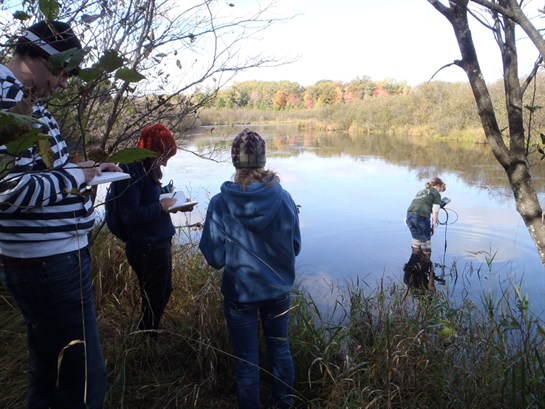 |
|
Students collecting water quality field parameters of surface waters in Manistee National Forest in Michigan. |
Another monitoring network in the Forest is designed to detect hydrologic changes that might result from climate change and from ecosystem transformation due to restoration of native Savanna ecosystems. At that site, the team downloaded groundwater level data and used a bailer to collect groundwater samples for water quality analysis.
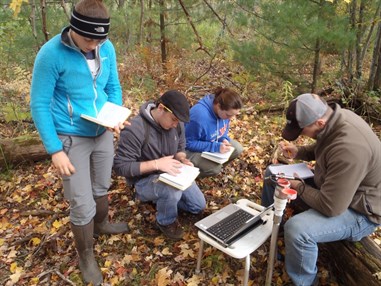 |
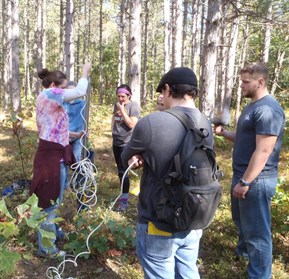 |
| Students downloading data from a groundwater well in Manistee National Forest in Michigan. | Students using a bailer to recover groundwater for assessing water quality. |
After the work was completed, the group enjoyed a visit to Little Sable Lighthouse on the Lake Michigan Coastline south of Ludington, Michigan. On the trip back home, a stop for lunch included competitive rock-skipping at Indiana Dunes National Lakeshore. Students on the trip included Rachel Bacher, Seth Backes, Jennifer Campbell, Holly Hume, Lauren Maurer, Scott Miller, Kellan Scherry, and Lauryn Yevincy.
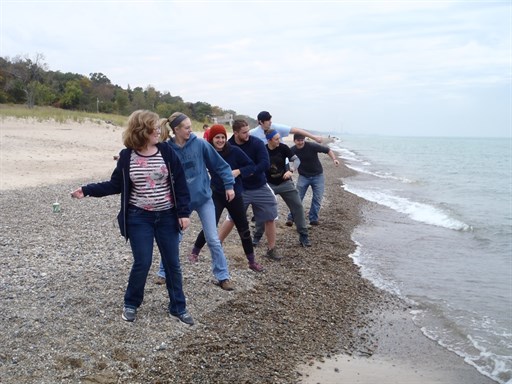 |
| Students skipping stones at Indiana Dunes along the Lake Michigan shoreline. |
To top things off, work initiated during the Hydrogeology class by Bacher, Campbell, Maurer, and Anna Starks (who did not attend the field trip), has developed into a focused research project (Hydrogeological Impacts of Savanna Ecosystem Restoration and Regional Climate Change, and the Potential Consequences for Endangered Species Management, in Manistee National Forest, Michigan). Preliminary results from the work will be presented at the 2016 North-Central Section meeting of the Geological Society of America.
Radon Hazards in Southwest Indiana – September 2015
Dr. Kent Scheller and Dr. William Elliott published a paper entitled “Geochemical and gamma-ray characterization of Pennsylvanian black shales: Implications for elevated home radon levels in Vanderburgh County” in the Journal of Environmental Radioactivity in August 2015. In addition, a public lecture summarizing the results of this study, “RADON: Health, Hazards, and your Home” will be presented on September 24, 2015 at 6:30 PM in ED 1101 at USI.
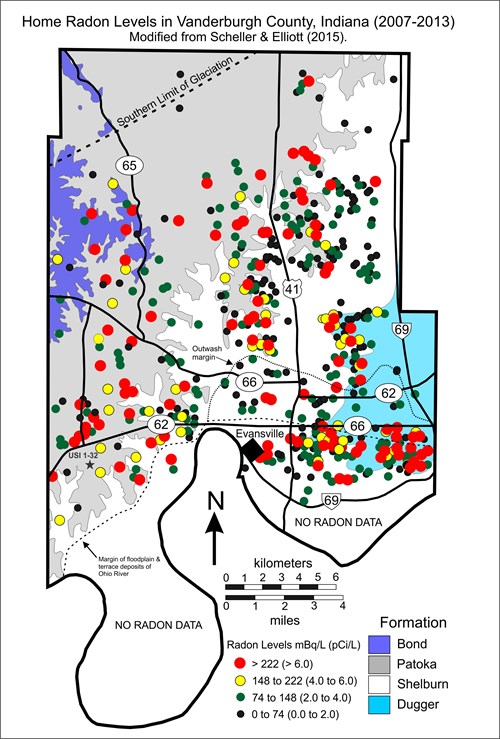 |
| Distribution of elevated radon levels in Vanderburgh County, Indiana. Note that about 80 percent of elevated radon levels occur in proximity to the contacts of geologic formations. Black shales that have elevated concentrations of uranium (~100 to 200 ppm) stratigraphically occur at these formational contacts. |
Approximately 23 percent of homes tested in Vanderburgh County from 2007 to 2013 had elevated radon levels (greater than 4.0 pCi/L). An additional 33 percent of homes had measured radon levels of 2.0 to 3.9 pCi/L. About 80 percent of elevated radon levels (greater than 4.0 pCi/L) are located in proximity to depositional contacts between the Dugger and Shelburn formations, or the Shelburn and Patoka formations. These formational contacts are stratigraphically associated with Pennsylvanian black shales, which are interpreted to be the ultimate source of radon in Vanderburgh County, Indiana. Moreover, high radon levels also occurred in homes built on alluvium, terrace deposits, and outwash adjacent to the Ohio River. These elevated levels are probably due to transmission of radon through soil gas in highly permeable sands and gravels sourced from buried bedrock exposures of Pennsylvanian black shales.